NCERT Solutions Class 10 Maths
Chapter – 8 (Introduction to Trigonometry)
The NCERT Solutions in English Language for Class 10 Mathematics Chapter – 8 Introduction to Trigonometry Exercise 8.1 has been provided here to help the students in solving the questions from this exercise.
Chapter : 8 Introduction to Trigonometry
- NCERT Class 10 Maths Solution Ex – 8.2
- NCERT Class 10 Maths Solution Ex – 8.3
- NCERT Class 10 Maths Solution Ex – 8.4
Exercise – 8.1
1. In ∆ ABC, right-angled at B, AB = 24 cm, BC = 7 cm. Determine:
(i) sin A, cos A
(ii) sin C, cos C
Solution – In a given triangle ABC, right angled at B = ∠B = 90°
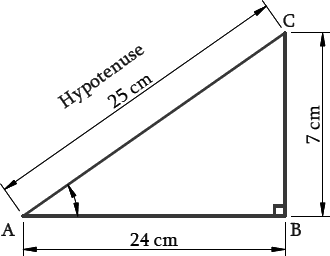
Given : AB = 24 cm and BC = 7 cm
According to the Pythagoras Theorem,
AC2 = AB2 + BC2
= 242 + 72
= 576 + 49 cm2
= 625 cm2
AC = 25
(i) sin A = BC/AC = 7/25
cos A = AB/AC = 24/25
(ii) sin C = AB/AC = 24/25
cos C = BC/AC = 7/25
2. In Fig. 8.13, find tan P – cot R
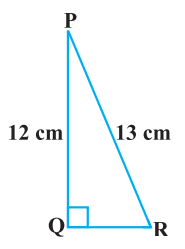
Solution – In the given ΔPQR, the given triangle is right angled at Q and the given measures are:
PR = 13cm,
PQ = 12cm
According to Pythagorean theorem,
PR2 = PQ2 + QR2
(13 cm)2 = (12 cm)2 + QR2
169 cm2 = 144 cm2 + QR2
25 cm2 = QR2
QR = 5 cm
tan P = QR/PQ
tan P = 5/12
cot R = QR/PQ
cot R = 5/12
tan P – cot R = 5/12 – 5/12 = 0
3. If sin A = 3/4, calculate cos A and tan A.
Solution – Let us assume a right angled triangle ABC, right angled at B
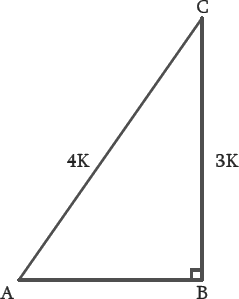
Given : Sin A = 3/4
BC/AC = 3/4
Therefore, hypotenuse AC will be 4k where k is a positive integer.
Applying Pythagoras theorem on ∆ABC, we obtain:
AC2 = AB2 + BC2
AB2 = AC2 – BC2
AB2 = (4k)2 – (3k)2
AB2 = 16k2 – 9k2
AB2 = 7 k2
AB = √7 k
Now, we have to find the value of cos A and tan A
cos A = AB/AC = √7k/4k = √7/4
tan A = BC/AB = 3k/√7k = 3/√7
4. Given 15 cot A = 8, find sin A and sec A.
Solution – Let us assume a right angled triangle ABC, right angled at B
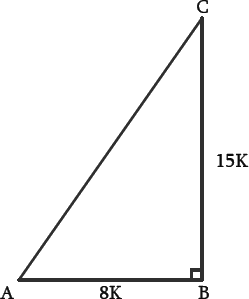
Given : 15 cot A = 8
Cot A = 8/15
AB/BC = 8/15
Applying Pythagoras theorem in ΔABC, we obtain.
AC2 = AB2 + BC2
AC2 =(8k)2 + (15k)2
AC2 = 64k2 + 225k2
AC2 = 289k2
AC = 17k
Now, we have to find the value of sin A and sec A
sin A = BC/AC = 15k/17k = 15/17
sec A = AC/AB = 17k /8k = 17/8
5. Given sec θ = 13/12 Calculate all other trigonometric ratios
Solution – Let ΔABC be a right-angled triangle, right-angled at B.
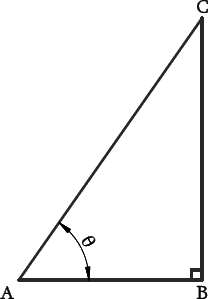
Given : sec θ = 13/12 = Hypotenuse/Adjacent side = AC/AB
Let AC be 13k and AB will be 12k
By Pythagoras theorem we get,
AC2=AB2 + BC2
(13k)2= (12k)2 + BC2
169k2= 144k2 + BC2
169k2= 144k2 + BC2
BC2 = 169k2 – 144k2
BC2= 25k2
Therefore, BC = 5k
Now, substitute the corresponding values in all other trigonometric ratios
sin θ = BC/AC = 5/13
cos θ = AB/AC = 12/13
tan θ = BC/AB = 5/12
cosec θ = AC/BC = 13/5
cot θ = AB/BC = 12/5
6. If ∠A and ∠B are acute angles such that cos A = cos B, then show that ∠ A = ∠ B.
Solution – Let us assume the triangle ABC in which CD ⊥ AB
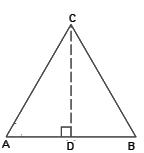
Give that the angles A and B are acute angles, such that
cos A = cos B
As per the angles taken, the cos ratio is written as
AD/AC = BD/BC
AD/BD = AC/BC
Let take a constant value
AD/BD = AC/BC = k
Now consider the equation as
AD = k.BD ———- (i)
AC = k BC ———- (ii)
By applying Pythagoras theorem in △CAD and △CBD we get,
CD2 = BC2 – BD2 ———- (iii)
CD2 =AC2 −AD2 ———- (iv)
From the equations (iii) and (iv) we get,
AC2−AD2 = BC2−BD2
⇒ (kBC)2 – (kBD)2 = BC2 – BD2
⇒ k2(BC2 – BD2) = BC2 – BD2
⇒ k2 = 1
⇒ k = 1
Putting this value in equation (ii), we obtain
AC = BC
∠A = ∠B (Angles opposite to equal sides of a triangle are equal-isosceles triangle)
7. If cot θ = 7/8, evaluate :
(i) (1 + sin θ)(1 – sin θ)/(1+cos θ)(1-cos θ)
(ii) cot2 θ
Solution – Let us assume a △ABC in which ∠B = 90° and ∠C = θ

Given :
cot θ = BC/AB = 7/8
BC = 7k
AB = 8k
According to Pythagoras theorem in △ABC we get.
AC2 = AB2+BC2
AC2 = (8k)2 + (7k)2
AC2 = 64k2 + 49k2
AC2 = 113k2
AC = √113 k
According to the sin and cos function ratios, it is written as
sin θ = AB/AC = 8k/√113k = 8/√113
cos θ = BC/AC = 7k/√113 k = 7/√113
Now apply the values of sin function and cos function:
(i)
=
= =
=
(ii) cot2 θ
= =
8. If 3 cot A = 4, check whether (1-tan2 A)/(1+tan2 A) = cos2 A – sin 2 A or not.
Solution – Let △ABC in which ∠B=90°
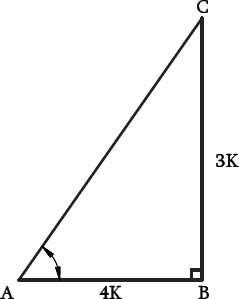
3 cot A = 4
cot A = 4/3 = AB/BC
Let AB = 4k an BC =3k,
According to the Pythagorean theorem,
AC2 = AB2 + BC2
AC2 = (4k)2 + (3k)2
AC2 = 16k2 + 9k2
AC2 = 25k2
AC = 5k
Now, apply the values corresponding to the ratios
tan A = BC/AB = 3/4
sin A = BC/AC = 3/5
cos A = AB/AC = 4/5
Now compare the left hand side(LHS) with right hand side(RHS)
L.H.S. = (1 – tan2A)/(1 + tan2A)
= (1 – (3/4)2)/(1 + (3/4)2)
= (1 – 9/16)/(1 + 9/16)
= (16 – 9)/(16 + 9)
= 7/25
R.H.S. = cos2A – sin2A
= (4/5)2 – (3/4)2
= (16/25) – (9/25)
= 7/25
R.H.S. = L.H.S.
Hence,
(1 – tan2A)/(1 + tan2A) = cos2A – sin2A
9. In triangle ABC, right-angled at B, if tan A = 1/√3 find the value of:
(i) sin A cos C + cos A sin C
(ii) cos A cos C – sin A sin C
Solution – Let ΔABC in which ∠B=90°

tan A = BC/AB = 1/√3
BC = 1k
AB = √3 k,
By Pythagoras theorem in ΔABC we get:
AC2 = AB2 + BC2
AC2 = (√3 k)2 + (k)2
AC2 = 3k2 + k2
AC2 = 4k2
AC = 2k
Now find the values of cos A, Sin A
Sin A = BC/AC = 1/2
Cos A = AB/AC = √3/2
Then find the values of cos C and sin C
Sin C = AB/AC = √3/2
Cos C = BC/AC = 1/2
Now, substitute the values in the given problem
(i) sin A cos C + cos A sin C
= (1/2) × (1/2 ) + √3/2 × √3/2
= 1/4 + 3/4
= 1
(ii) cos A cos C – sin A sin C
= (√3/2 )(1/2) – (1/2) (√3/2 )
= 0
10. In ∆ PQR, right-angled at Q, PR + QR = 25 cm and PQ = 5 cm. Determine the values of sin P, cos P and tan P
Solution – In a given triangle PQR, right angled at Q, the following measures are
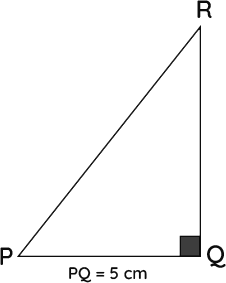
PQ = 5 cm
PR + QR = 25 cm
Now let us assume, QR = x
PR = 25 – QR
PR = 25- x
According to the Pythagorean Theorem,
PR2 = PQ2 + QR2
Substitute the value of PR as x
(25 – x) 2 = 52 + x2
252 + x2 – 50x = 25 + x2
625 + x2-50x -25 – x2 = 0
-50x = -600
x= -600/-50
x = 12 = QR
Now, find the value of PR
PR = 25 – QR
PR = 25 – 12
PR = 13
Now, substitute the value to the given problem
sin p = QR/PR = 12/13
cos p = PQ/PR = 5/13
tan p = QR/PQ = 12/5
11. State whether the following are true or false. Justify your answer.
(i) The value of tan A is always less than 1.
(ii) sec A = 12/5 for some value of angle A.
(iii) cos A is the abbreviation used for the cosecant of angle A.
(iv) cot A is the product of cot and A.
(v) sin θ = 4/3 for some angle θ.
Solution –
(i) The value of tan A is always less than 1. (False)
because tan 60° = √3 > 1
(ii) sec A = 12/5 for some value of angle A. (True)
As hypotenuse is the largest side, the ratio on RHS will be greater than 1. Hence, the value of sec A is always greater than or equal to 1. Thus, the given statement is true.
(iii) cos A is the abbreviation used for the cosecant of angle A. (False)
Abbreviation used for cosecant of ∠A is cosec A and cos A is the abbreviation used for cosine of ∠A. Hence the given statement is false.
(iv) cot A is the product of cot and A. (False)
cot A is not the product of cot and A. It is the cotangent of ∠A. Hence, the given statement is false.
(v) sin θ = 4/3 for some angle θ. (False)
We know that in a right angled triangle, Hypotenuse is the longest side.
∴ sin θ will always less than 1 and it can never be 4/3 for any value of θ.

Leave a Reply